How to niche an eco-lodge into a birding-lodge
Manual for creating a birding lodge. An example of strategy from Iquitos Peru.
A couple of weeks ago I was invited to Amazon Refuge up the Yanayacu creek south of Iquitos. It served as a great base for birding this rich Igapó forest (blackwater flooded forest). One of the key birds here, is a relatively recent finding. The Endangered Wattled Curassow.
Ten years ago, the Wattled Curassow was thought to be practically exterpiated from Peru. Then came rumors of sightings by fishermen from the fishing village of San Juan de Yanayacu. All of a sudden the Wattled Curassow was not only present in Peru, but in fact quite accessible.
Of the three areas in South American where you can spot one, Yanayacu is the easiest. In Bolivia it is a very long journey and at the site in the Brazilian Amazon, the birds are difficult to see. So for a very special birds and a fantastic Varzea/Igapó experience the Yanayacu area has a secure place for visiting birders in the future.
I had been in the area before visiting a lodge called Loving Light, which seemed to be doomed then and now has been abandoned. The forest will soon “eat” the wood construction and the jungle will once again rule. There are two other lodges in the area none which specialize towards birders. I was invited to see whether the Amazon Refuge was a lodge we could for our clients. Also, I wanted to get a better view of the Wattled Curassow. My last visit gave a piss poor view of a large black bird behind dense foliage flying away as I looked the way the guide was pointing. It was the bird. It could be nothing else -but not very satisfying.
The Amazon Refuge is last outpost in the complex waterways of the Yanayacu. Up the creek is the newly created communal reserve and the wild Amazon. It is a privileged location. It could not be any better. Scott Robinson (legendary record holder with Ted Parker of the World Big Day record of 331 species from Manu without using aircrafts or cars) saw Wattled Curassow 50 meters from the lodge during the dry season (late May through November). That is dry season as in lower water level and exposed trails for walking. It still rains of course. Why do you think they call it rain forest, duh? The rain in the Andes sets the water level of the Amazon.
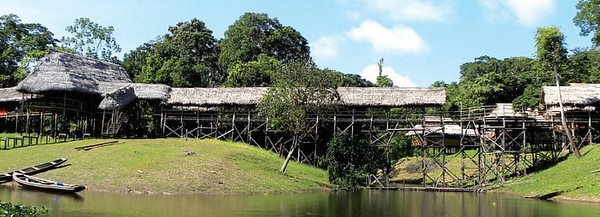
Amazon refuge - dry season
There are 5 spacious two-bed rooms with private bath and a large dining hall. It is built on poles, and it is amazing to realize that the water level difference is around 7 meters! 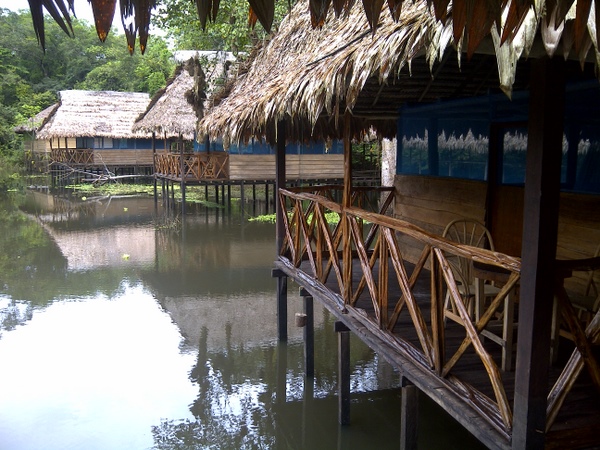 For birders who want a big list, low water is better, but on the other hand, the serenity of high water paddling the trails rather than walking was a fantastic experience.
For birders who want a big list, low water is better, but on the other hand, the serenity of high water paddling the trails rather than walking was a fantastic experience.  Wildlife was abundant I recorded 5 species of monkeys without leaving the lodge. And I saw Three-toed Sloth, as well as pink and gray river dolphins.
Wildlife was abundant I recorded 5 species of monkeys without leaving the lodge. And I saw Three-toed Sloth, as well as pink and gray river dolphins. 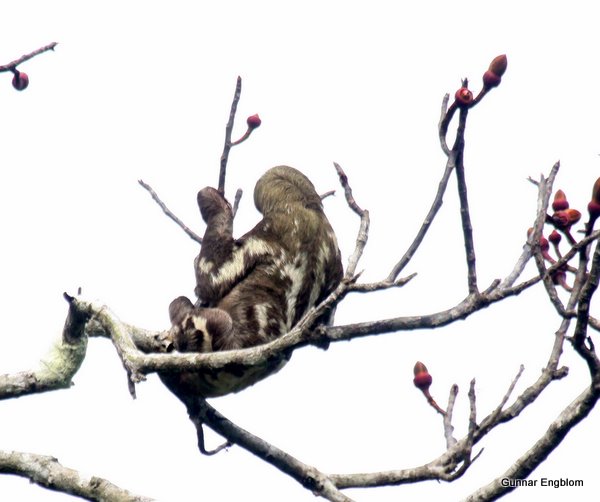 The food was excellent and the bar was well stocked. One would think with such a perfect lodge it would be full all the time, but the lodge was started 3 years ago, and then came the US recession. It has not been easy to sell tours to here. Surely, it could have helped if the owners had done more marketing and visited trade shows, but that cost a lot of money and there are only 10 beds. Bob Todd, one of the owners, told me that the lodge is actually for sale. (Special price: A mere US$300,000 – and a Paradise on Earth is yours. Sell your house and come and live in Peru!). The owners would like to keep the lodge, but the reality is that an other owner with capital to invest in the marketing and some final adjustments such as putting in hot water (not essential but nice), build some more cabins, and build a canopy tower and an aerial for capturing telephone signal and Internet, would have a better chance of selling and market the lodge.
The food was excellent and the bar was well stocked. One would think with such a perfect lodge it would be full all the time, but the lodge was started 3 years ago, and then came the US recession. It has not been easy to sell tours to here. Surely, it could have helped if the owners had done more marketing and visited trade shows, but that cost a lot of money and there are only 10 beds. Bob Todd, one of the owners, told me that the lodge is actually for sale. (Special price: A mere US$300,000 – and a Paradise on Earth is yours. Sell your house and come and live in Peru!). The owners would like to keep the lodge, but the reality is that an other owner with capital to invest in the marketing and some final adjustments such as putting in hot water (not essential but nice), build some more cabins, and build a canopy tower and an aerial for capturing telephone signal and Internet, would have a better chance of selling and market the lodge.
But what if….
What if it was made it into a birding lodge? We talked to the small hours at the lodge of a strategy to make an eco-lodge in to birding lodge. Let’s face it, there are simply too many eco-lodges in Iquitos. Even if you see more wildlife at Amazon Refuge, the other lodges are already filling all the market slots and have covered the regular eco-tourists who basically just want to see a bit of jungle and a few monkeys. If you have perfectly niched lodge for a specific group it would be much easier and less costly group to market to. If niched, you could simply ask someone in field to write about it and publish on a birding site on the internet or in a birding magazine. If you’d do everything in your might to make it in to a VERY Birder Friendly lodge – it shall be easy to get the customers. Hey, if your lodge is so good for birders, you may not want to sell the lodge in the end.
Strategy for turning a regular eco-lodge into a birder’s lodge.
1. Identify the key species and the star birds.
 Zimmer’s Woodcreeper Xiphorhynchus kiernii. Yanayacu. Photo: Gunnar Engblom
Zimmer’s Woodcreeper Xiphorhynchus kiernii. Yanayacu. Photo: Gunnar Engblom
There are two species that are extremely hard to get elsewhere that can be seen here. Wattled Curassow of course and Zimmer’s Woodcreeper. These are birds that will get birders to look at Yanayacu for a couple of days. From competing with all the other lodges around Iquitos that cater to eco-tourists in general, when targeting to birders, you only compete with the two other lodges in the Yanayacu creek. Here is where it gets interesting. Birders could stay at the other lodges, but none of them are catering specifically to birders and are not as well situated in the midst of the forest. The points below are the ones that will sell to birders. There are a number of birds that also give added value to the birder. Leks for the colorful Manakins and Cotingas should be well staked out in before hand. Roost for Potoos and Owls should also be marked. Nests for big raptors such as Harpy, Crested or any of the Hawk-Eagles should be monitored. An active nest is a great sales point.
2. Record sightings.
Start keeping a bird log at the lodge where clients and local guides put down their best observations and where exactly they have seen the birds. Make detailed trailmaps over the area, name the trails and mark the trails every 100m. Then if an interesting bird such as a lek of say Black-necked Red Cotinga is spotted on for example “Anaconda Trail” between 11o0 and 1200 meter mark, and this is put down in the birdlog, then the next visitor could go back a week later to the same spot and play the song of the Cotinga with the iPod and perhaps there may be a loose lek there and an immediate response.
3. In house bird guides.
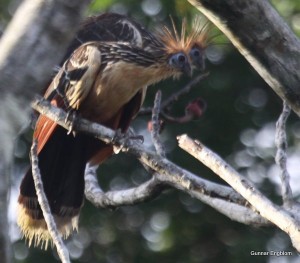 The best bird guides will be those that are born in the area and know the forest inside out. They already know all the calls and sounds of the forest. They already know what all the creatures look like. In most cases they can identify the right bird just by hearing a call. But often there are no names available for them. This can be helped. They need:
The best bird guides will be those that are born in the area and know the forest inside out. They already know all the calls and sounds of the forest. They already know what all the creatures look like. In most cases they can identify the right bird just by hearing a call. But often there are no names available for them. This can be helped. They need:
- A bird guide. Luckily now Birds of Peru is published in Spanish and not very expensive.
- A full list of the birds possible in the area. A list with some 300-400 species of birds should go a long way.
- The need mp3 players with all the calls of these 300 birds.
Now in very short time they shall be able to connect the dots to be able to know what bird every call is and show that in the book to a visiting birder. This concept was vital for marketing lodges in Ecuador such as La Selva Lodge and Sacha Lodge. The same strategy was used by myself to train our native guides. It works. It is important to learn the basic playback techniques. But by watching the visiting birders they will soon learn the skills.
- with a Radio Shack 9 volt loud speaker they can call in the birds with the mp3 player
- Unknown songs need to be recorded and played back. There are many inexpensive recorders that will record in mp3 or WMA with built in mics that do a remarkable job of catching calls from far away. The signal may not be very loud, but when amplified with the Radio Shack speaker the bird will come closer. Repeating the same procedure the recorder may end up with a much better recording.
- Binoculars: Yes, they will eventually become essential. With a good project that benefit a local community, the ABA program Birder’s Exchange could be of help to provide donated binoculars and other important equipment to the future guides.
4. Learn English.
The local guides don’t speak English. They will have a hard time learning to speak it fully. However, as birdguides they don’t need to explain the full breeding biology of the Yellow-rumped Casique. They just need to show the bird. They need to learn 300 words in English. That is all. They have to learn the bird names in English. One of the local guides Juan Carlos is also part owner of Amazon Refuge knows English already and speaks it well. He could teach his friend who will become birdguides the 300 words they need and how to pronounce them.
5. Give direction in English
I tell you a story. My guides Alex and Antonio are both from the rain forest. They speak decent English. But them describing where the bird is in the tree was very hard to follow. I tried to teach them the clock system. You know, think of the tree as a clock (that is a clock with handles – not a digital one) with straight up being 12 and 6 the low central part, 3 and 9 is straight out right and left of the center of the tree. When I say the bird in the tree is at 4:30 it should be clear, right? Instead I got the question: Is that 4:30 AM or 4:30 PM? When you think about it – it is not so strange. Who needs a watch in the jungle. They probably did not learn to read the clock as kids as there is no need to in the jungle. Stay out after dark and you’d be eaten by the jaguars. That is all a jungle kid needs to know. Forget it. I bought them a green light laser pointer each. That is what the local guides need.
A green light laser pointer and learn to say: See the dot?, Yes! Follow the dot! 1 meter below the dot. Yes? YES! 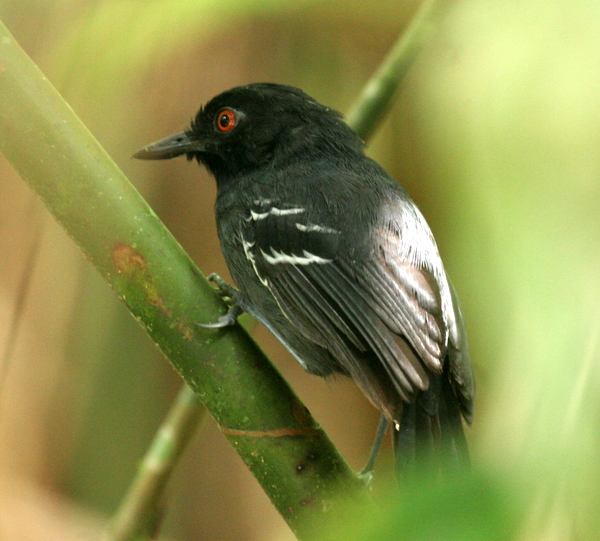
6. Create viewing facilities at the lodge it self.
Probably the most important deal for the lodge to make it different to the other lodges that caters to normal eco-tourists, is to make good viewing facilities for birders at the lodge itself. It comes down to a couple of quite easily arranged items.
- Hummingbird feeders. Probably the most straight forward way to create added value for birders at a lodge. In fact it is added value for anyone. Note that it may take as long as 3 months for the hummers to find the resource. Don’t give up. To start with you don’t even have to buy hummingbird feeders. They are easily made. Check this Video.
- Feeding tables. A simple contruction on which you put fruit, rice and/0r seeds will attract fruit and seedeating birds. In South America feeding tables containing fruit such as bananas, papaya, water melon etc attract the gaudy colorful tanagers.
- Plants. There are many trees and bushes that are excellent to attract hummingbirds and fruit eating birds. At Amazon Refuge they will be limited to potplants. One of the best that should work is the Blue Porterweed Stachytarpheta jamaicensis, which attract loads of hummers at for example Amazonia Lodge mentioned in Rich Hoyer’s post.
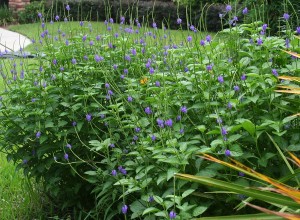
- Canopy platform. Viewing the canopy birds at eye-level is a definite added value to the birder and to the non-birder a great way to experience the rainforest from above. The simplest and least expensive way is to construct a platform in a Ceiba tree and haul up passengers in a harness with mountain climbing equipment. Later with more investments it is a good idea to invest in a stair-case in either metal or wood.
- Hide at compost pile. The compost, where you deposit all your organic waste, is great attracting animals and birds. Make a simple hide, so that the they can be observed.
- Birdbaths. During hot days through-out the dry season, creating birdbaths at strategic points will be important. When birds find the baths they will become regular points where the birds will visit. A basic hide can be set up here as well.
7. No wild animals as pets.
There are very few lodges that are pet free. Wild animals are offered to the lodges all the time to the lodges, both confiscated animals that need a home or animals in caught in the wild. For birders it can actually be made a point, that without pets the lodge does not contribute to create a demand. Domestic animals should not be held either at the lodge as they can transmit deseases to the wild populations. 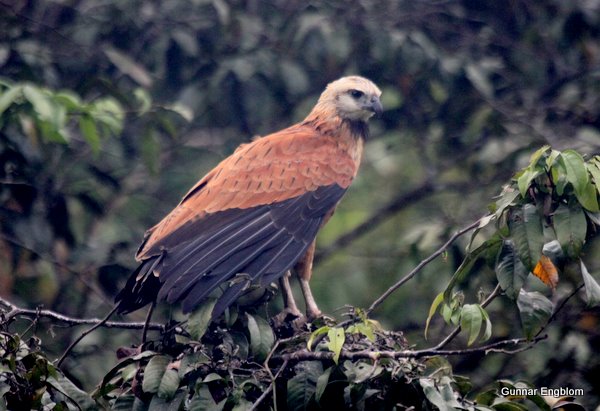
8. Internet – wifi
OK. I know sounds like the last thing you would want when you are on holiday. Why bring work with you. However, the lure of updating Facebook and Twitter – and send off a photo of the Curassow when seen to Flickr or a video to YouTube – is simply unresistable for the birders. Birders love to show off what they have seen. This is immediate advertsing through the social networks. The cost of installing internet will soon be covered by the free advertising you are getting.
9. Social Media plan
Every one who is involved with the lodge and who have access to computers, should have personal accounts in the four big Social Media sites: Facebook, Twitter, You Tube and Flickr – and maybe also the new Google plus – the Ring that will Rule them All. Additionally, there should should be a Facebook Page and a YouTube channel for the lodge itself. There should also be a WordPress blog on the web-site, in which new content is posted on a regular basis. (I am getting so involved with the social media plan for my own company, that I sometimes think I should start a consultancy business on the side on the subject 🙂 )
10. Web-page
The web-page should be designed for birders. There need to be photos of interesting birds for the birders. For Amazon Refuge the special birds of the area should be mentioned and as many photos as possible of these species should be displayed. In the end the birds are the thing that sells. It is a good idea to let the birders know which birds they can see and photograph, by showing pictures of these. There should also be a downloadable preferably annotated checklist of the birds seen at the lodge – with details of abundance and best place where to see the regularly occuring birds, as well as notes on when, where, how and by whom for the rarer observations.
Special Birds at Amazon Refuge.
It could be worth making some lists of special birds from the area. Both to let future visitors know what to look out for and for the lodge owners as well as the local guides to learn which birds have higher value to birders. Lodges that want to promote to birders, should learn that a page full of pictures of common birds such as Yellow-rumped Casique, Great Egret or Great Kiskadee will sell less trips to birders, while a web-site that show special birds is right on.
The Yanayacu is the next river south of the Tahuayo river. Tahuayo has a number of birds that are very difficult elsewhere in Peru. Many of these will certainly be found also at Yanayacu creek and the Amazonon Refuge with time. They should be searched for by the local guides. If found, the value for birders to come to Amazon Refuge would be even higher.
Special birds almost impossible to get elsewhere: Wattled Curassow and Zimmer’s Woodcreeper.
Restricted Range species: Black-tailed Antbird
Good birds recorded at Yanayacu: Rufous-headed Woodpecker, Rufous-capped Nunlet, Scaled Spinetail, Orange-fronted Plushcrown, Dusky-chested Flycatcher
Varzea/Igapo specialties: Plain-breasted Piculet, Rufous-capped Nunlet, Slender-billed Xenops, Amazonian Antshrike, Plumbeous Antbird, Yellow-crowned Elaenia, Royal Flycatcher, Dusky-tailed Flatbill, Varzea Mourner, Gray-chested Greenlet.
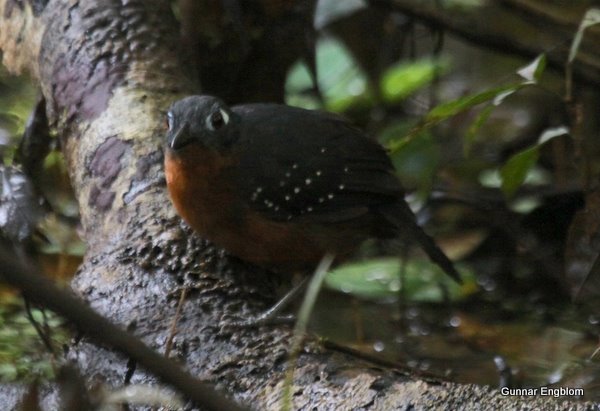
Female Plumbeous Antbird Myremciza hyperythra. Photo: Gunnar Engblom. Yanayacu.
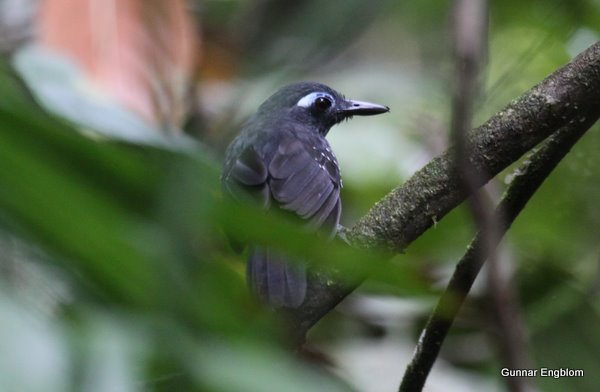
Male Plumbeous Antbird Myremciza hyperythra. Photo: Gunnar Engblom. Yanayacu.
Terra Firme: Black-throated Trogon, Bluish-cheeked Jacamar, Rufous-necked Puffbird, Chestnut-capped Puffbird, Collared Puffbird, Bar-bellied Woodcreeper Spot-throated Woodcreeper, Saturnine Antshrike, Wire-tailed Manakin, Dot-backed Antbird.
Mauritia palm stands: Point-tailed Palmcreeper, Sulphury Flycatcher, Red-bellied Macaw
Nightbirds: Zig-Zag Heron, Boat-billed Heron, Great Potoo, Long-tailed Potoo, Spectacled Owl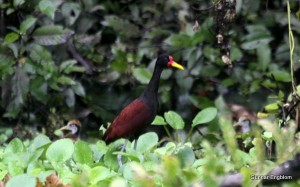
On the water-conspicous birds: Horned Screamer, Black-collared Hawk, Green Ibis, Sungrebe, 5 species of Kingfishers, Slate-colored Hawk, White-eared Jacamar, Wattled Jacana, Hoatzin, Velvet-fronted Grackle, Red-and-white Spinetail, Plum-throated Cotinga, Band-tailed Oropendula
Parrots: Iquitos is notorious for parrot trade and even eating macaws. Therefor, it is a relief to find good parrots in the Yanayacu such as Blue-and-Yellow Macaw, Rose-fronted Parakeet, Festive Parrot and Short-tailed Parrot 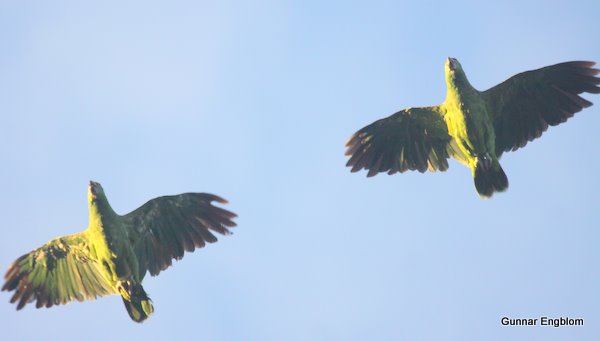 River islands: These are not birds of the Yanayacu, but the river island specialist birds on islands on the Ucayali river, will be yet another resource if the newly trained guides know how to find them. The islands could be visited on the day of arrival or departure. Both old mature islands with swamps and second growth with old Cecropia dominated forest as well as young islands with Gynerium cane and the willow-like Tessaria integrifolia. Look out for the following: Ash-breasted Antbird, Black-and-White Antbird, Castelnau’s Antshrike, Olive-spotted Humminbird, Fuscous Flycatcher, Bicolored Conebill, Pearly-breasted Conebill, Parker’s , White-bellied and Red-and-White Spinetails, Riverside Tyrant, Lersset Hornero and Black-banded Crake
River islands: These are not birds of the Yanayacu, but the river island specialist birds on islands on the Ucayali river, will be yet another resource if the newly trained guides know how to find them. The islands could be visited on the day of arrival or departure. Both old mature islands with swamps and second growth with old Cecropia dominated forest as well as young islands with Gynerium cane and the willow-like Tessaria integrifolia. Look out for the following: Ash-breasted Antbird, Black-and-White Antbird, Castelnau’s Antshrike, Olive-spotted Humminbird, Fuscous Flycatcher, Bicolored Conebill, Pearly-breasted Conebill, Parker’s , White-bellied and Red-and-White Spinetails, Riverside Tyrant, Lersset Hornero and Black-banded Crake
Tahuayo birds to be searched for: These are three rock heavy birds which by no means are easy at Tahuayo, but yet could well occur in the vecinity of Yanayacu – Rufous-winged Wood-Rail, Red-billed Ground-Cuckoo and Amazonian Black-Tyrant. If they are found this will additionally add to the value for visiting birders. I am working on a combined checklist for the birds of Yanayacu and Tahuayo. If anyone wants a copy in excel-format just write me.
Finally, what is essential to you in a birding lodge?

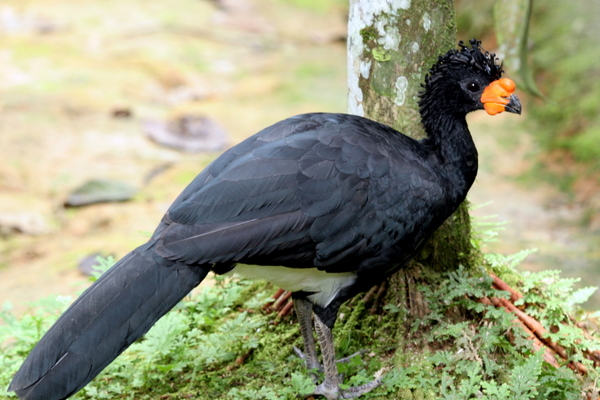
What a great idea. I agree. Wish I could do it myself! great shots. Love that wattled curassow!
Thanks Kathie. I did point out that in the article that the photo of the Curassow is a “pet” from Explornapo. The cere should be more reddish, rather than orange on wild individuals.
Gunnar,
Interesting article on a topic that I’ve been involved with over the last couple of years. Here are a few more recommendations: 1) recruit volunteer birders to come to the lodge and, in exchange for room and board, act as guides and consultants; 2) network with other birding-oriented lodges in Peru to create itineraries for birders who wish to visit a variety of habitats; the networked lodges can also help to refer visitors to their “sister” lodges and can pool their resources for advertising, attending bird fairs, etc.; 3) encourage visiting birders to publish trip reports at TravelingBirder.com, Surfbirds, etc. Trip reports provide highly credible and influential word-of-mouth advertising; 4) seek out free or low-cost web-based advertising exposure at sites such as BirdingPal.com, Where Do You Want to Go Birding Today?, 10,000 Birds, etc.
Thanks Bob
I agree with all your points. Those are good strategies, especially when the first 10 have been addressed. But on immediate term there shall be a volunteer staying there for a month that will interact with the community and teach the English birdnames.
South Africa has successfully created “birding routes” – this involves a fair amount of planning and cooperation but is beneficial to both hosts and clients. It also adds another dimension for marketing. Relates to your No. 2 Bob.
Also involve the local community as much as possible – not only will this support your endeavors but there should also be a significant local conservation benefit and potential to the local communities. Location will obviously play a big role here.